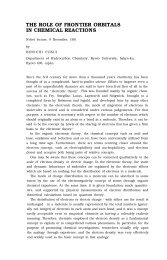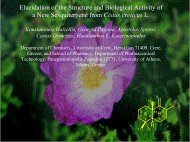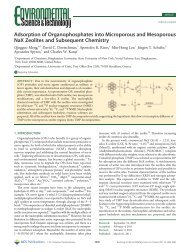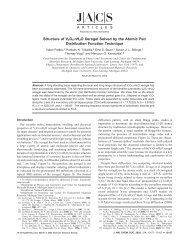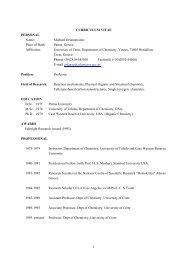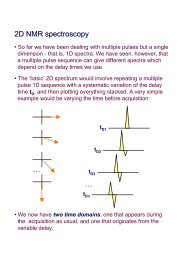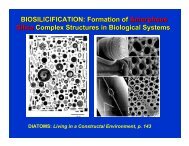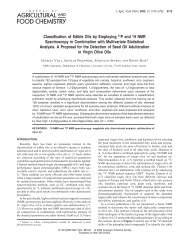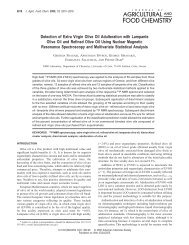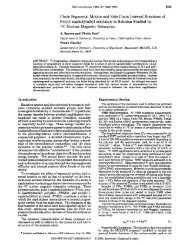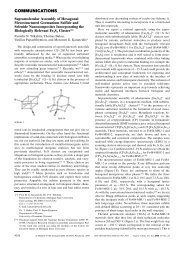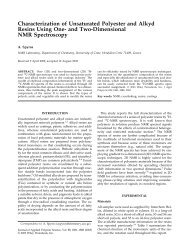Humic Acids: Marvelous Products of Soil Chemistry - Department of ...
Humic Acids: Marvelous Products of Soil Chemistry - Department of ...
Humic Acids: Marvelous Products of Soil Chemistry - Department of ...
You also want an ePaper? Increase the reach of your titles
YUMPU automatically turns print PDFs into web optimized ePapers that Google loves.
<strong>Chemistry</strong> for Everyone<br />
Supramolecular models <strong>of</strong> HS structures are being put<br />
forward (21, 25) and the supramolecular chemistry <strong>of</strong> HSs is a<br />
new and exciting field (25). Instead <strong>of</strong> single monomeric<br />
species, HSs are being described as micelles, colloids, aggregates,<br />
vesicles, fractals, clathrates, and surfactants. Macroscopic surface<br />
areas are being measured and their morphological features<br />
described. Advanced computer modeling is predicting shapes,<br />
folding patterns, and metal chelation sites (32).<br />
Macromolecular architecture and surface features can be<br />
measured by atomic force microscopy (AFM) and other<br />
microprobe techniques (20, 36 ). The shapes and properties<br />
<strong>of</strong> HSs can be dramatically altered in response to changes in<br />
pH or ionic strength and exposure to minerals (20, 36 ). The<br />
actual behavior <strong>of</strong> HSs in natural soil and water environments<br />
is a function <strong>of</strong> the molecular structure, which has important<br />
implications for contaminant mobility, aggregation, and<br />
adhesion to clay surfaces.<br />
<strong>Humic</strong> Substances in Drinking Water<br />
There is an old saying in the Wild West: “Whiskey is<br />
for drinking, but water is for fighting.” Battles over water<br />
rights are not only a characteristic <strong>of</strong> the western USA but<br />
also a worldwide phenomenon. In recent years, however, the<br />
battle lines have focused on drinking water quality as well as<br />
ownership.<br />
Surface waters contain a range <strong>of</strong> inorganic salts and<br />
organic solutes. These waters are required to be treated and<br />
disinfected by the Environmental Protection Agency (EPA)<br />
as well as local governmental agencies, thus adding more<br />
ingredients to the water. Odor and taste properties have been<br />
affected as a result. These treatments have caused a change<br />
in the public perception <strong>of</strong> municipal tap water. In the past<br />
10 years there has been a sharp increase in the consumption<br />
<strong>of</strong> bottled water as a result <strong>of</strong> the public suspicion <strong>of</strong> tap water.<br />
Possibly the most influential group <strong>of</strong> organic solutes in<br />
surface waters are HSs, specifically HAs and FAs. Although<br />
benign and even therapeutic in themselves, these humates<br />
react with disinfectants to produce disinfection by-products<br />
(DBPs), which are toxic and regulated by the EPA. The most<br />
common disinfectant in municipal treatment plants is chlorine.<br />
It reacts with HSs to produce chlor<strong>of</strong>orm and other<br />
hal<strong>of</strong>orms, which are classified by the EPA as trihalomethanes<br />
(THMs). This reaction, the hal<strong>of</strong>orm reaction (eq 1), is a<br />
common topic in sophomore organic chemistry.<br />
OH + RCOCH 3 + 3Cl 2 → RCOO + CHCl 3 + 3HCl (1)<br />
The yield <strong>of</strong> chlor<strong>of</strong>orm strongly depends on the apparent<br />
molecular weight <strong>of</strong> the humic acid species (37). Many other<br />
halogenated aromatic and aliphatic products (DBPs) are also<br />
produced, but all <strong>of</strong> them in much smaller quantities than the<br />
THMs. The THMs are potential carcinogens: approximately<br />
10,000 people a year in the USA contract bladder or colon<br />
cancer from drinking chlorinated waters (38). At present,<br />
municipal water suppliers must limit the concentration <strong>of</strong><br />
THMs to less than 80 µg/kg (80 µg/L, or ppb for dilute<br />
aqueous solutions) in the potable water distribution system.<br />
Faced with the EPA restrictions, municipal water companies<br />
have used technologies to reduce the production <strong>of</strong><br />
THMs. Two methods commonly used in water treatment<br />
plants are (i) alternate disinfectants to chlorine, such as ozone,<br />
chloramine, and chlorine dioxide, and (ii) removal <strong>of</strong> humic<br />
acids from the source (raw) water.<br />
The first method is most widely used. The second is<br />
more expensive; it employs filters such as activated charcoal,<br />
anthracite, or treated sand. None <strong>of</strong> the filtration systems<br />
remove all the humic substances, but they can reduce chlor<strong>of</strong>orm<br />
levels to meet EPA guidelines.<br />
One other method <strong>of</strong> removing humic acid from surface<br />
waters relies on nature itself. It is known as soil aquifer treatment<br />
(SAT) and utilizes soil as the filter. By percolating raw<br />
water into large basins, water managers can recharge the aquifer<br />
while removing much <strong>of</strong> the humic acid (39). The treated,<br />
stored water can then be pumped to the municipal water<br />
delivery system when needed.<br />
Redox Properties <strong>of</strong> <strong>Soil</strong> <strong>Humic</strong> <strong>Acids</strong><br />
<strong>Soil</strong> humic acids are redox polymers. Although they can<br />
act as oxidants and reductants, their most common behavior<br />
under natural conditions is as reducing agents. The standard<br />
reduction potential <strong>of</strong> a typical soil HA is 700 mV (40). In<br />
other words, humic acids are capable <strong>of</strong> reducing Fe(III),<br />
Sn(IV), V(V), and Cr(VI). In return, certain functional groups<br />
in HA are oxidized. Some possible candidates are catechol<br />
moieties (oxidized to quinones), phenolic groups (to free<br />
radicals or quinhydrones), aldehydes (to carboxylic acids),<br />
and alcohols (to aldehydes or carboxylic acids).<br />
Oxidation and reduction <strong>of</strong> HAs is a reversible, repeatable<br />
process (41) that takes place in one-electron steps. The intermediate<br />
species is a semiquinone free radical. The phenolic<br />
and quinone groups in the HA polymer are the functional<br />
groups responsible for this redox behavior (5, 19).<br />
Recently, a number <strong>of</strong> commercial products derived from<br />
HAs have capitalized on these remarkable reducing properties<br />
(42). <strong>Humic</strong> acids derived from natural sources are crosslinked<br />
with polymers to make them insoluble in water. These<br />
products are then able to detoxify soils and surface waters<br />
contaminated with toxic organic and inorganic chemicals. Some<br />
metals are reduced from toxic valence states to a nontoxic<br />
state—for example, Cr(VI) to Cr(III). More striking is the<br />
reductive cleavage <strong>of</strong> halogenated hydrocarbons. Substances like<br />
trichloroethylene (TCE), a very common pollutant in soils<br />
and ground water, are dehydrohalogenated to ethylene and<br />
HCl (43, 44). This reduction corresponds to the reduction<br />
<strong>of</strong> TCE by elemental iron! A very bright future is envisioned<br />
for the detoxification applications <strong>of</strong> humic substances.<br />
Solid HAs as Sorbents and Metal Binders<br />
Solid humic acids have large sorption capacities for hydrophilic<br />
and hydrophobic solutes. 13 C NMR spectra show<br />
that soil HAs consist <strong>of</strong> aliphatic and aromatic backbones<br />
with the aromatic fraction rarely exceeding 50% <strong>of</strong> the total<br />
carbon (45, 46 ). Functional groups such as –COOH give<br />
hydrophilic character to HAs. Aliphatic chains give HAs<br />
flexibility, while the aromatic units are rigid. This is why HAs<br />
can interact with so many different solutes.<br />
Sorption <strong>of</strong> hydrophobic organic compounds occurs by<br />
partitioning/dissolution into an amorphous phase (47) or<br />
interaction with rigid units such as stacked aromatic rings<br />
(48). One piece <strong>of</strong> evidence for specific interactions is to have<br />
1612 Journal <strong>of</strong> Chemical Education • Vol. 78 No. 12 December 2001 • JChemEd.chem.wisc.edu




